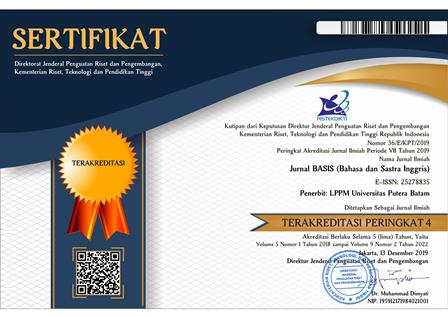ILLOCUTIONARY FORCE OF SLANG WORDS IN "RAMPAGE" 2018 MOVIE
DOI:
https://doi.org/10.33884/basisupb.v9i2.6360Keywords:
imitative, illocutionary force, Rampage, slang wordAbstract
Slang words can contain particular meanings that cannot be interpreted directly. To know and understand the meaning behind the utterances, EFL learners can employ illocutionary force by analyzing the native speakers' daily communication of slang words. Therefore, this qualitative research aimed to explore the types of slang words and the illocutionary force behind the utterances in the Rampage movie. The data were collected from the movie transcript and analyzed using document analysis to explore the types of slang words and the illocutionary force. The analysis results revealed that all types of slang words were discovered in the movie, and the most used type was imitative, which occurred 14 times. The illocutionary force that underlined the characters implementing the slang words was to show that the speakers have higher status than the interlocutor, understand what they need to do in certain situations, ask other people to do something, want to show their psychological state, and they want to give a promise. The results of this study would enrich EFL learners' knowledge of slang words in particular and their vocabulary items in general.
References
Agsa, J., & Ambalegin. (2020). The form of slang terms in the “Kingsman: The golden circle” movie. Linguistic, English Education and Art (LEEA) Journal, 3(2), 400–413. https://doi.org/10.31539/leea.v3i2.1260
Allan, K., & Burridge, K. (2006). Forbidden words: Taboo and the censoring of language. Cambridge University Press.
Aspers, P., & Corte, U. (2019). What is qualitative in qualitative research. Qualitative Sociology, 42(2), 139–160. https://doi.org/10.1007/s11133-019-9413-7
Austin, J. L. (1962). How to do things with words. The Clarendon Press.
Bouman, W. P., Schwend, A. S., Motmans, J., Smiley, A., Safer, J. D., Deutsch, M. B., Adams, N. J., & Winter, S. (2017). Language and trans health. International Journal of Transgenderism, 18(1), 1–6. https://doi.org/10.1080/15532739.2016.1262127
Budiasa, I. G., Savitri, P. W., & Dewi, A. A. S. S. S. (2021). Slang Language in Indonesian Social Media. Lingual: Journal of Language and Culture, 11(1), 30. https://doi.org/10.24843/ljlc.2021.v11.i01.p06
Creswell, J. W. (2013). Research design: qualitative, quantitative, and mixed methods approach (4th ed.). SAGE Publications Inc.
Denzin, N. K., & Lincoln, Y. S. (2017). The sage handbook of qualitative research. SAGE Publications Inc.
Fusch, P., Fusch, G. E., & Ness, L. R. (2018). Denzin’s paradigm shift: Revisiting triangulation in qualitative research. Journal of Social Change, 10(1), 19–32. https://doi.org/10.5590/josc.2018.10.1.02
Grant, T. (2017). Duppying yoots in a dog eat dog world, kmt: Determining the senses of slang terms for the Courts. Semiotica, 216, 479–495. https://doi.org/https://doi.org/10.1515/sem-2015-0082
Haucsa, G. M., Marzuki, A. G., Alek, A., & Hidayat, D. N. (2020). Illocutionary speech acts analysis in Tom Cruise’s interview. Academic Journal Perspective : Education, Language, and Literature, 8(1), 11. https://doi.org/10.33603/perspective.v8i1.3304
Hidayat, A. (2016). Speech acts: Force behind words. English Education: Jurnal Tadris Bahasa Inggris, 9(1), 1–12. https://doi.org/http:ejournal.radenintan.ac.id/index.php/ENGEDU
Izazi, Z. Z., & Tengku-Sepora, T. M. (2020). Slangs on social media: Variations among Malay language users on Twitter. Pertanika Journal of Social Sciences and Humanities, 28(1), 17–34.
Izmaylova, G. A., Zamaletdinova, G. R., & Zholshayeva, M. S. (2017). Linguistic and Social Features of Slang. International Journal of Scientific Study, 5(6), 3–7. https://doi.org/10.17354/ijssSept/2017/016
Johnson, C. R. (2020). Mansplaining and illocutionary force. Feminist Philosophy Quarterly, 6(4). https://doi.org/10.5206/fpq/2020.4.8168
Kartika, A., & Pangestu, M. (2019). The reasons of the main character in using slang words in Deadpool 2 movie directed by David Leitch. Wanastra: Jurnal Bahasa Dan Sastra, 11(1), 53–60. https://doi.org/10.31294/w.v11i1.4963
Macagno, F., & Capone, A. (2016). Uncommon ground. Intercultural Pragmatics, 13(2), 151–180. https://doi.org/10.1515/ip-2016-0007
Mackieson, P., Shlonsky, A., & Connolly, M. (2019). Increasing rigor and reducing bias in qualitative research: A document analysis of parliamentary debates using applied thematic analysis. Qualitative Social Work, 18(6), 965–980. https://doi.org/10.1177/1473325018786996
Merisabel, D., Arifin, M. B., & Valiantien, N. M. (2020). The study of slang utterances in Brick movie. Ilmu Budaya: Jurnal …, 4(April), 238–249. http://e-journals.unmul.ac.id/index.php/JBSSB/article/view/2859
Naderifar, M., Goli, H., & Ghaljaie, F. (2017). Snowball sampling: a purposeful method of sampling in qualitative research. Strides in Development of Medical Education, 14(3). https://doi.org/10.5812/sdme.67670
Ratri, A., & Bram, B. (2022). Illocutionary acts and contextual utterances in the movie Raya and the Last Dragon. PIONEER: Journal of Language and Literature, 14(1), 58–74. https://doi.org/doi.org/10.36841/pioneer.v14i1.1523
Searle, J. R., & Vanderveken, D. (1985a). Foundations of illocutionary logic. Cambridge University Press.
Searle, J. R., & Vanderveken, D. (1985b). Speech act and illocutionary logic. In D. Vanderveken (Ed.), Logic, Thought and Action (1st ed., pp. 109–132). Springer.
Sinaga, M., Sumarsih, D., & Husein, R. (2018). Teachers’ language style with reference to sex differences in teaching English. 200(2001), 566–569. https://doi.org/10.2991/aisteel-18.2018.123
Situmorang, R. K., & Herman. (2021). An analysis of slang language styles used in Charlie’s Angels movie. Journal of English Educational Study (JEES), 4(1), 21–29. https://doi.org/10.31932/jees.v4i1.820
Sobola, E. (2018). An analysis of the illocutionary force of metaphor of abuse in a Nollywood movie–house of trouble. Eksu Studies in Language and Literature (ESILL), 6(1), 104–111.
Sudiyanti, L. N., Suarnajaya, I. W., & Swandana, I. W. (2018). A descriptive analysis of slang words used in “step up: all in” movie. Jurnal Pendidikan Bahasa Inggris Undiksha, 5(2). https://doi.org/doi.org/10.23887/jpbi.v5i2.13585
Sugiyono. (2014). Quantitative, qualitative, and R&D research methods. Alfabeta.
Wardhaugh, R. (2010). An introduction to sociolinguistics (6th ed.). Wiley-Blackwell.
Wiruma, T., & Azmi, A. (2018). Slang expression in Little Man movie based on social dimension. 15(2), 97–113. https://doi.org/10.30957/lingua.v15i2.480.2

















